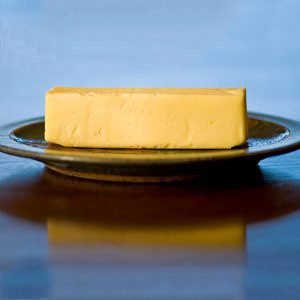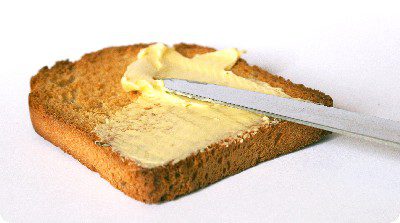
When I think of sitting at the kitchen table as a child eating dinner, I don’t have memories of luscious homemade foods. I don’t see fresh pasta or fried tortillas. I don’t see tarts or puddings. I see margarine. To be clear, I see a mound of white rice, cooked in a saucepan, sitting to the side of a bone-in pork chop, topped with a tablespoon of margarine.
I was hosting a dinner party for friends once, when someone asked me to pass the butter. The woman, a neighbor, hesitated for a moment, and then asked if it was butter or margarine.
“Butter,” I said.
“Oh, good,” she said.
Someone else nodded in agreement. Another declared he hadn’t had margarine in years.
Soon the margarine-bashing began. The color: too yellow. The texture: waxy. A friend’s husband went so far as to say he always knew what kind of house he was in by the butter or butter substitute they served, and those homes that served butter substitutes would not have him as guest again anytime soon. You’d think someone had mentioned taxes or lutefisk, so palpable was the disgust.
I nodded along, conceding that butter was indeed much better. My significant other gave me a wink. You see, he and I were new to living together and what butter to buy had been one of our first turf battles. He was a no-margarine-in-the-house kind of guy. And me? Well, like my mother, I ate margarine.
“It’s healthier,” I said. “It’s the perfect balance between low fat and non-hydrogenated oils.”
“But it tastes bad.”
“No it doesn’t. You can’t even tell the difference.” The fridge door was open and we were both looking in at the yellow tub, one of those non-hydrogenated smart spreads. I had just returned from shopping and we were unloading the groceries.
“Um, yes, you can. And it can’t be good for you. It’s processed.”
Processed. The world alone can cause heart problems. I didn’t retort. I left him to put away the onions and peanut butter and that was the end of it, until the following week when I went to the grocery store and, in a moment of remorse, bought the butter, which was how it came to be on our table that night.
Our disagreement was nothing when compared to a news item out of Waterville, Washington: “A culinary argument between a brother and sister about whether to use butter or margarine turned violent, resulting in an attack with a knife-edged barbecue spatula, police say.” The article goes on to explain that while the seventeen-year-old sister was making macaroni and cheese, her brother questioned her butter choice, resulting in the sister’s attempt to cut his throat with a serrated spatula.
*
Margarine, or oleomargarine, was invented in 1869 by Hippolyte Mège-Mouriès, a French chemist. I’m guessing, like Oppenheimer, he had no idea that his commitment to science would produce such unsavory results. But he surely understood its potential to rival butter, a market which had never before been challenged. The invention caused a panic in the dairy industry, and less than a decade after margarine made a play for old bread’s affections, laws were passed in the United States to restrict its sale. The substance was heavily taxed, making it more expensive, and stores had to be licensed to sell it, leading to the rise of “margarine moonshiners”—businessmen selling margarine on the sly.
Price wasn’t the only problem. A cartoon accompanying a 1911 Chicago Tribune article shows cats, tin cans, and arsenic thrown into a vat of margarine. Consumers didn’t really understand what margarine was made of and its suspicious origins led them to wonder if it was safe, a fear that has resurfaced from time to time throughout the last century.
Margarine is not made from arsenic, although it might seem so if you asked my dinner guests. It has the same basic makeup as butter, 20% water and 80% fat. The difference between the two is the type of fat used and the way it’s processed. Butter is made by whipping cream, taken from milk, until the membranes of the fat globules break down, allowing the fats to conjoin and from a solid: butter.
Margarine, conversely, is made from vegetable fats. Oil is extracted from corn and soy seeds. It is then purified and, until recently, hydrogenated. The hydrogenation process turns runny oil into a solid substance. But unlike cream, you can’t just take out the hand held mixer and break down the fats. Rather, hydrogen gas is pumped through the oil, changing the carbon bonds. Initially, the oil is made up of unsaturated bonds, but the addition of hydrogen results in saturated bonds, which are what turn it into a solid. Manufacturers restricted the number of saturated bonds and ensured only those needed to create the desired texture were produced. Fully hydrogenated oil resembles hard rubber.
“I remember when we used to go to the lake in Wisconsin in the summer,” my father says. “The margarine would come in a bag and it would be white. It would come with an orange capsule and each time a different one of us kids would get to mix the capsule in by squeezing the bag. It turned the margarine yellow.”
My father is referring to the fact that when margarine is manufactured it is naturally a whitish-gray substance. Only after adding dye does it turn yellow. For years the dairy lobby made it illegal for margarine to be sold with color added, thereby making it less appealing. Wisconsin, where milk is the official state beverage, was the last to cave and allow for the sale of pre-dyed margarine.
In the late 1950s, about the time my father was squishing around the orange capsule, saturated fats, which are naturally found in meat and dairy products, were linked to heart disease. Because margarine manufactures could restrict the number of saturated bonds in their product, margarine had less saturated fat than butter and was seen as the healthier choice.
It would be another four decades before other, more serious, problems with the hydrogenation process were discovered. The high temperatures used in the process flip some of the carbon bonds into the “trans” form, creating trans fats. In 1993, a Harvard study found participants who ate significant amounts of trans fats were twice as likely to have a heart attack. In 1997, the leader of that study called hydrogenation “the biggest food-processing disaster in U.S. history.”
*
“I felt duped,” says my friend, a wife and mother in her mid-thirties. “I just felt duped.” When margarine was unmasked many weren’t sure what to think. For Danna, it was the moment her trust in conventional food wisdom began to erode. She watched for other conflicting food science discoveries. There they were: coffee and chocolate, carbs and calories, fish and fat. The information was complex, continually changing, often hard to remember and even harder to abide by.
Now she buys her almonds from Europe because they aren’t pasteurized. She juices entire heads of organic kale and spinach and calls it breakfast. The snacks she brings to her son’s baseball games contain not even a drop of corn syrup. On a visit to her home, she made me “bread” from dehydrated bananas. The food dehydrator sat in the kitchen making a low hum for hours, only to produce a thin crepe-like substance with a distinct banana flavor.
Over the last decade, organic and natural food markets have grown steadily. Market analysts connect the growth to consumers concerns over sustainability and obesity. Personally, I think it all has to do with margarine. Consumers were happy to trust America’s food manufacturing processes. Not only happy, but at times smug.
My own butter tendencies were most affected by the non-fat craze of the 1980s and ’90s. Chocolate cake? Sure, just as long as it was non-fat. Diet Coke was a diet food, 0 calories and 0 grams of fat. Reduced fat Triscuits and 99% fat-free yogurt. It took so little to feel like you were doing so much. With every Snackwell’s Devil’s Food Cookie Cake, I felt my tummy tighten. And so it was with margarine. We humans were outsmarting food.
Then the largest food-processing disaster in history befell us. The demand for less processed food and ingredients that were easier to pronounce began.
I ask Danna about non-hydrogenated margarines, which manufactures were quick to create once the writing was on the FDA’s wall. “Oh no,” she says, “I don’t trust those.” She can’t exactly tell me why, in all her research she hasn’t exactly figured out what poison is in this new product, but she is sure there is one. And she is not about to be fooled again.
*
A comment left on the website that posted the Waterville Washington sibling rivalry story says, “Anyone that would choose margarine over butter should be put to the knife…I spit on your grave.”
“Better yet,” someone else adds, “we spit on their kitchens!”
This sort of zealousness is usually reserved for politics and religion. I imagine trying to get to know someone and asking, “What’s your sign? Democrat or Republican? Butter or margarine?”
The debate runs deep, because whatever we choose to eat, it feels like we do so on faith. Guidelines seem tenuous. Rules are broken. We decide for ourselves what is good and what is not, and then defend our choice with a serrated barbecue spatula if needed. In Roland Barthes’s Mythologies, 1957, he uses three examples publicists can use to convince an audience of the quality of something despite its drawbacks: the army, the church, and margarine.
*
My grandmother will cut off a tablespoon of butter and pop it in her mouth to savor while she cooks. She loves butter. Mashed potatoes, carrots and peas, over-easy eggs, all swimming in butter. I can remember being a small child, sitting in her farm kitchen, eating a roast and potatoes, both so rich with fat I felt sick. She grew up on a farm and made butter as a regular chore. “Fresh-baked bread and homemade butter,” she says. “Heavenly.”
My grandmother was born in 1924, shortly after the end of WWI. The war had done wonders for margarine. Dairy products were hard to come by, and in certain areas had to be rationed, so margarine became a kind of savior. However, during the Depression, butter once again became the condiment of choice. Dairy lobbyists claimed buying butter was one way to support your farmer-neighbor. Unable to afford store-bought products, many Americans made butter at home. Then, with World War II, the pendulum swung again, and margarine came back into favor. Soon, claims about its health benefits gave it the staying power it needed.
“Then we all bought margarine for a long time,” my grandmother says, somewhat sadly. “Because they said it was better for us.” She stresses the word “they.” In these matters, there is always a “they.” She goes on to say that she secretly knew butter was better; she always preferred butter. She sounds vindicated.
Butter is back. It’s the cool condiment, the thinking man’s condiment, loved by television chiefs and restaurateurs alike. Publicly, I have become a butter convert. I felt compelled. After all, I seem to run with butter snobs. Still, I am nostalgic for margarine. Not the taste or the texture, but the hope—the orderly aisle of little yellow tubs, nonfat cookies, my mother’s indelible confidence that she is doing what’s best as she stands in our kitchen watching the evening news, one hand on her hip the other holding a spatula, frying pork chops and waiting for the rice to be done. The margarine is already on the table.
***
Listen to Paula read her essay:
***
First image by Flickr user madlyinlovewithlife.





